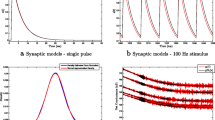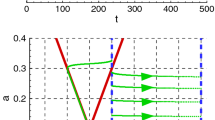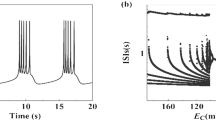Abstract.
The balance between inhibition and excitation plays a crucial role in the generation of synchronous bursting activity in neuronal circuits. In human and animal models of epilepsy, changes in both excitatory and inhibitory synaptic inputs are known to occur. Locations and distribution of these excitatory and inhibitory synaptic inputs on pyramidal cells play a role in the integrative properties of neuronal activity, e.g., epileptiform activity. Thus the location and distribution of the inputs onto pyramidal cells are important parameters that influence neuronal activity in epilepsy. However, the location and distribution of inhibitory synapses converging onto pyramidal cells have not been fully studied. The objectives of this study are to investigate the roles of the relative location of inhibitory synapses on the dendritic tree and soma in the generation of bursting activity. We investigate influences of somatic and dendritic inhibition on bursting activity patterns in several paradigms of potential connections using a simplified multicompartmental model. We also investigate the effects of distribution of fast and slow components of GABAergic inhibition in pyramidal cells. Interspike interval (ISI) analysis is used for examination of bursting patterns. Simulations show that the inhibitory interneuron regulates neuronal bursting activity. Bursting behavior patterns depend on the synaptic weight and delay of the inhibitory connection as well as the location of the synapse. When the inhibitory interneuron synapses on the pyramidal neuron, inhibitory action is stronger if the inhibitory synapse is close to the soma. Alterations of synaptic weight of the interneuron can be compensatory for changes in the location of synaptic input. The relative changes in these parameters exert a considerable influence on whether synchronous bursting activity is facilitated or reduced. Additional simulations show that the slow GABAergic inhibitory component is more effective than the fast component in distal dendrites. Taken together, these findings illustrate the potential for GABAergic inhibition in the soma and dendritic tree to play an important modulatory role in bursting activity patterns.
Similar content being viewed by others
Acknowledgments.
This research is supported by NIH grant NS38958. A preliminary version of this work was presented at Computational Neuroscience and American Epilepsy Society 2001 Annual Meetings.
Author information
Authors and Affiliations
Corresponding author
Rights and permissions
About this article
Cite this article
Yang, KH., Franaszczuk, P. & Bergey, G. The influences of somatic and dendritic inhibition on bursting patterns in a neuronal circuit model. Biol. Cybern. 89, 242–253 (2003). https://doi.org/10.1007/s00422-003-0429-3
Received:
Accepted:
Published:
Issue Date:
DOI: https://doi.org/10.1007/s00422-003-0429-3




